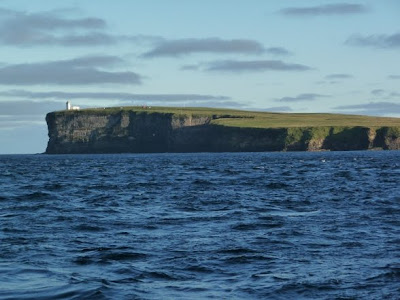Next (jumping back a few thousand years), we drove on another mile and a half to the Clava Cairns, a wonderful collection of three different neolithic tumuli, one an open passage grave, one an enclosed and once corbel-roofed passage grave (as in Ireland), and the middle one, something I have not seen, a chambered area, open, but with no entrance nor exit...a ring cairn. All are ten feet high or so and 75-100 feet in diameter, and are oriented to the SW and the winter solstice sunset. Most interestingly, they all size the kurb and other stones, smaller toward the sunset and larger back from it. And, the kurb and outer circle stones are color-coordinated. See illustration. The outer circle of the SW tumulus also has double-stones—one very large, others smaller. Again, something new to me.
Quite a few of the kurbstones have cup marks, suggesting more recycling from previous aeons. Cup marks are both paleolithic and neolithic, found all over Europe. This was thousands of years before metallurgy, especially in these parts, so it was stone on stone, day after day, to cut one of these little figures into, typically, granite or schist. Every one of them must have meant a great deal to whomever was chipping away at them. And we have not the merest clue as to what they or their cup-and-ring figure relations might have meant. “Sublime” generally refers to gigantic natural features...mountains, glaciers, desert wastes...but I am always in awe of these human vestiges. Somehow, they put things in a different perspective, in a different dimension.
Or, as Vicki observes, hey, no internet, no DVDs, no television, nothing to read: what are you going to do?
We camped at the Clava Cairns car park, way off the main roads, near the Firth of Moray, deep in farm country.
Lest anyone be concerned, we're eating well. Dinner tonight was Scottish breakfast, eggs, tomatoes, mushroom, toast, beef lorne, fruit pudding, black (blood) pudding, and beef links, washed down by Dark Island, the best dark brew I have yet had (from the Orkneys, “5,000 years in the making”). Cholesterama.
 |
| All three of the Clava Cairns |
 |
The northeastern-most cairn, used to have a corballed roof,
like in Ireland |
 |
| Middle cairn, the ring cairn |
 |
| No exit; no entrance |
 |
Double-stones on the outer circle of the
southwestern-most cairn |
 |
| Color-coded stones |
 |
| Cup-mark city |
 |
| Dinner |




















































